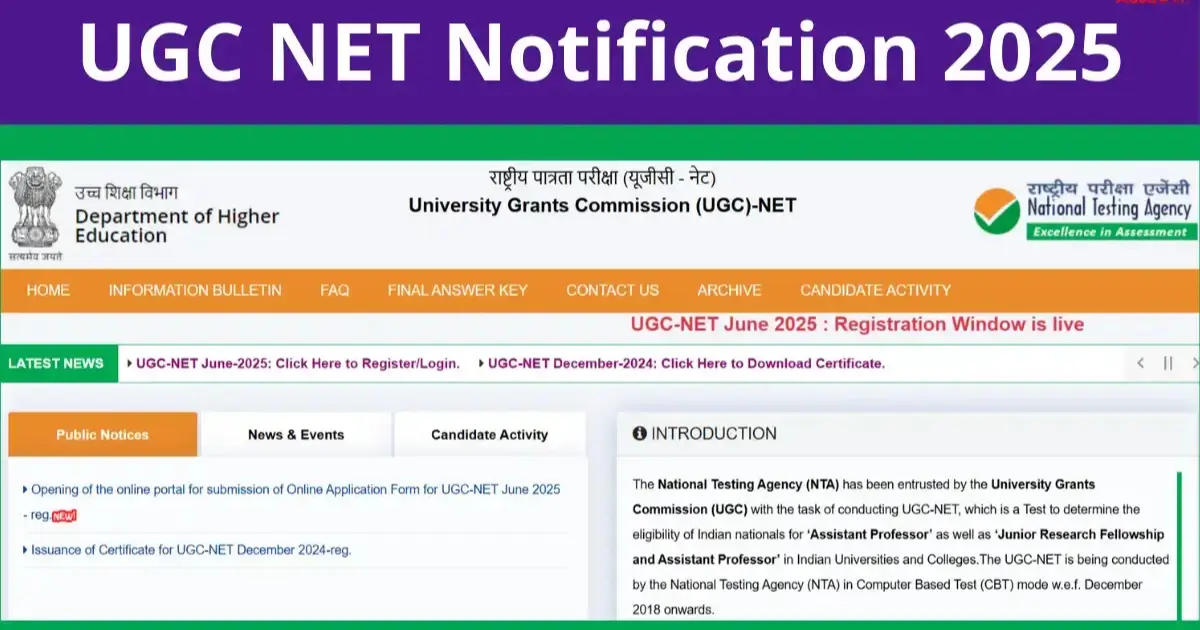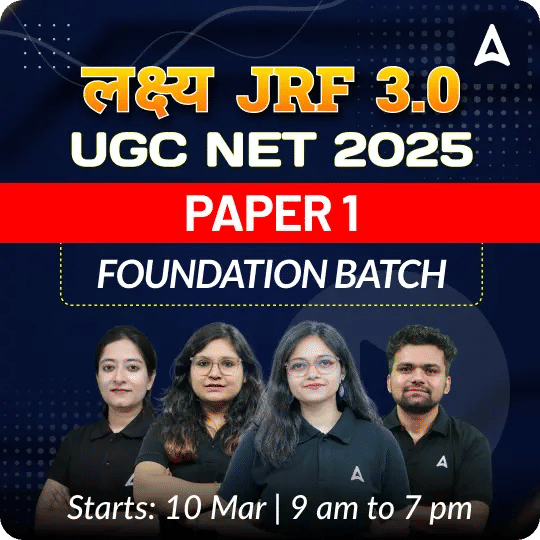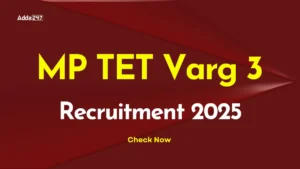Table of Contents
The National Testing Agency (NTA) has released the subject-wise UGC NET 2025 exam schedule for the June session on the official website ugcnet.nta.ac.in, along with the shift timings. The UGC NET June 2025 exam will be held from June 25 to June 29, 2025.
The UGC NET exam is conducted twice a year, in June and December.
Upcoming Event:
- Provisional Answer Key: Out
- Objection Window: Till 8 July 2025
- Exam Date: June 25 to June 29, 2025
UGC NET June 2025 Exam Date
According to the latest notice from the NTA, dated June 6, 2025, the UGC NET Exam 2025 will now be held from June 25 to June 29, 2025, in two shifts. The first shift will be from 9:00 a.m. to 12:00 p.m., and the second shift will be from 3:00 p.m. to 6:00 p.m. The exam will be conducted online (Computer-Based Test) for 85 subjects across India. The exam has three main purposes:
- To award Junior Research Fellowship (JRF) and recruit Assistant Professors.
- To recruit Assistant Professors and allow admission to Ph.D. programs.
- To allow admission to Ph.D. programs only.
UGC NET 2025 Admit Card
The National Testing Agency (NTA) has released the UGC NET Admit Card 2025 today i.e. 22 June 2025, for the June session. Candidates who have registered for the University Grants Commission National Eligibility Test (UGC NET) can download their call letter from the official website – ugcnet.nta.nic.in once it’s live.
UGC NET Exam City Intimation 2025 Out
The National Testing Agency (NTA) has released the UGC NET Exam City Intimation 2025, allowing candidates to check their allotted exam center details well in advance. Log in to the official NTA UGC NET portal using your application number and date of birth to view your exam city details, ensuring a smooth and well-planned exam day experience.
UGC NET June 2025 Subject Wise Exam Schedule
The subject-wise exam schedule for UGC NET June 2025 is now available on the official NTA website (ugcnet.nta.ac.in). Candidates should check their subject’s exam date and timing carefully. About 10 days before the exam, NTA will release the exam city intimation slip with details of the test center.
| Date | SHIFT – I (09:00 AM to 12:00 PM) | SHIFT – II (03:00 PM to 06:00 PM) | ||
|---|---|---|---|---|
| Subject Code | Subject Name | Subject Code | Subject Name | |
| 25 June 2025 | 009 | Education | 088 | Electronic Science |
| 014 | Public Administration | 045 | Japanese | |
| 103 | Indian Knowledge System | 058 | Law | |
| 022 | Malayalam | 063 | Mass Communication and Journalism | |
| 028 | Urdu | 034 | Nepali | |
| 055 | Labour Welfare / Personnel Management / Industrial Relations/ Labour and Social Welfare / Human Resource Management | 065 | Performing Arts – Dance/Drama/Theatre | |
| 068 | Criminology | 025 | Sanskrit | |
| 070 | Tribal and Regional Language/Literature | 074 | Women Studies | |
| 071 | Folk Literature | 059 | Library and Information Science | |
| 085 | Konkani | 003 | Philosophy | |
| 089 | Environmental Sciences | |||
| 26 June 2025 | 049 | Arab Culture and Islamic Studies | 002 | Political Science |
| 019 | Bengali | 072 | Comparative Literature | |
| 032 | Chinese | 036 | Assamese | |
| 087 | Computer Science and Applications | 095 | Santail | |
| 042 | Persian | 046 | Adult Education/ Continuing Education/ Andragogy/ Non-Formal Education. | |
| 043 | Rajasthani | 050 | Indian Culture | |
| 041 | Russian | 060 | Buddhist, Jaina, Gandhian, and Peace Studies | |
| 010 | Social Work | 067 | Archaeology | |
| 012 | Home Science | |||
| 016 | Music | |||
| 015 | Population Studies | |||
| 082 | Forensic Science | |||
| 27 June 2025 | 008 | Commerce | 030 | English |
| 011 | Defence and Strategic Studies | 100 | Yoga | |
| 031 | Linguistics | 090 | Politics, including International Relations/International Studies, Defence / Strategic Studies, West Asian Studies, Southeast Asian Studies, African Studies, South Asian Studies, Soviet Studies, and American Studies. | |
| 007 | Anthropology | 092 | Human Rights and Duties | |
| 079 | Visual Art (Including Drawing & Painting/Sculpture, Graphics/Applied Art/History of Art) | 102 | Hindu Studies | |
| 081 | Social Medicine & Community Health | 033 | Dogri | |
| 093 | Tourism Administration and Management. | 040 | Spanish | |
| 062 | Comparative Study of Religions | |||
| 84 | Kashmiri | |||
| 28 June 2025 | 094 | Bodo | 004 | Psychology |
| 005 | History | 018 | Mathhil | |
| 023 | Oriya | 029 | Arabic | |
| 083 | Pali | 037 | Gujarati | |
| 091 | Praktit | 017 | Management (including Business Admin, Mgt./Marketing/Marketing Mgt./Industrial Relations and Personnel Mgt./Personnel Mgt./Financial Mgt./Co-operative Management) | |
| 027 | Telugu | |||
| 047 | Physical Education | |||
| 073 | Sanskrit traditional subjects (including Jyotisha/Sidhanta Jyotish/Nayta Vyalarna/Vyalarma/Mimansa/Nayta Nyaya/Sankhya Yoga/Tulanatmaka Darsan/Shukla Yajirveda/Madhav Vedant/Dharmasasta/Sahliya/Puranothasa/Agama) | |||
| 105 | Ayurveda Biology | |||
| 104 | Disaster Management | |||
| 29 June 2025 | 039 | French (French Version) | 080 | Geography |
| 044 | German | 038 | Marathi | |
| 020 | Hindi | 024 | Punjabi | |
| 021 | Kannada | 026 | Tamil | |
| 035 | Manipuri | 001 | Economics / Rural Economics /Co-operation / Demography / Development Planning/Development Studies / Econometrics/ Applied Economics / Development Economics / Business Economics | |
| 101 | Sindhi | 066 | Museology & Conservation | |
| 005 | Sociology | |||
UGC NET 2025 Notification
The National Testing Agency (NTA) has officially released the UGC NET 2025 Notification for the June Cycle on its website. The examination will be conducted in Computer-Based Test (CBT) mode across 85 subjects. This national-level eligibility test determines qualification for:
- Junior Research Fellowship (JRF) and Assistant Professor positions
- Assistant Professor positions with Ph.D. admission
- Ph.D. admission in Indian universities and colleges
UGC NET Exam 2025
The UGC NET Notification 2025 has been officially released by the National Testing Agency (NTA) to determine eligibility for the Assistant Professor and Junior Research Fellowship (JRF) in Indian universities and colleges. Conducted twice a year (June & December), this national-level exam assesses candidates’ teaching and research aptitude across 85 subjects.
| UGC NET 2025 Exam Details | |
| Name of Exam | University Grants Commission National Eligibility Test (UGC NET) Exam 2025 |
| Conducting Body | National Testing Agency (NTA) |
| Mode of Application | Online |
| Total Subject | 85 |
| Mode of Exam | (Computer-Based Test – CBT) |
| UGC NET Application Form 2025 Begins | 16 April 2025 |
| UGC NET Application Form 2025 Date Extended | 12th May 2025 (Last date Reminder) |
| Last Date to Submit Application Fees | 13 May 2025 |
| Application Correction Window | 14 -15 May 2025 |
| UGC NET Exam Date 2025 | 25-29 June 2025 |
| Official Website | https://ugcnet.nta.ac.in/ |
| Notification |
|
UGC NET Application Form 2025
Candidates are advised to access the direct link to apply for the UGC NET 2025 Exam and get done with the application process as soon as possible. The UGC NET Application Form 2025 has been active till 12 May 2025 (Last date Reminder)through the provided link below. Candidates must not miss the great opportunity to secure their future in the Academic and Research field. The direct UGC NET 2025 Apply Link has been provided below for easy access.
UGC NET 2025 Application Form Link (Last date Reminder)
UGC NET 2025 Eligibility Criteria
The UGC NET (University Grants Commission National Eligibility Test) eligibility criteria are set by the National Testing Agency (NTA). Below are the key requirements for candidates appearing for the exam:
| Category | Eligibility Requirement |
|---|---|
| Nationality | Indian nationals |
| Age Limit (JRF) |
|
| Age Limit (AP) | No upper age limit |
| Education |
|
| Subject | Must match UGC NET subject list (85 subjects) |
| Attempts | No limit (if age & education criteria are met) |
| Relaxation |
|
| Appearing | Candidates in their final year or awaiting results are eligible to apply. |
Age Limit
The National Testing Agency (NTA) has specified age criteria for UGC NET 2025, varying based on the candidate’s category and purpose (JRF/Assistant Professor/PhD). Below is a detailed breakdown of the age criteria and relaxations:
| Category | Upper Age Limit (JRF) | Relaxation | Final Max Age with Relaxation | Assistant Professor/PhD |
|---|---|---|---|---|
| General/Unreserved | 30 years | – | 30 years | No age limit |
| OBC-NCL/SC/ST/PwD/Third Gender | 30 years | 5 years | 35 years | No age limit |
| Women Applicants | 30 years | 5 years | 35 years | No age limit |
| LL.M. Degree Holders | 30 years | 3 years | 33 years | No age limit |
| Ex-Armed Forces Personnel | 30 years | 5 years (service period) | 35 years | No age limit |
| Research Experience | 30 years | Up to 5 years (certified) | 35 years | No age limit |
UGC NET 2025 Exam Pattern
UGC NET Notification has been released, and candidates must check the exam pattern and syllabus of UGC NET to get an in-depth idea of the structure of the exam.
| Paper | Marks | Questions No | Duration (Shift-1) | Duration (Shift-2) |
| I | 100 | 50 | 1 Hr (9 am to 10 am) | 1 Hr (3:00 pm to 4:00 pm) |
| II | 200 | 100 | 2 Hr (10:00 am to 12:00 pm) | 2 Hr (4 pm to 6 pm ) |
UGC NET 2025 Syllabus
UGC NET Syllabus is crucial for applicants as it helps them determine the vastness of the curriculum. Candidates must remember that the syllabus for Paper I is constant; however, the Paper II syllabus will be subject-specific.
Hence, they must access the subject-wise syllabus of the respective subject they have applied for. Check the link below for the UGC NET Syllabus 2025 for Paper 1&2 PDF. NTA has released the NET Syllabus 2025 PDF.
Validity of UGC NET Score
After achieving a valid UGC NET score that exceeds the cutoff or qualifying marks, candidates will receive a UGC NET certificate. According to the latest guidelines from the NTA and UGC, the UGC NET score for the Junior Research Fellowship (JRF) is valid for three years from the date the JRF certificate is issued. In contrast, the score for Assistant Professorship is valid indefinitely. Therefore, candidates’ UGC NET scores are valid for a lifetime in the case of Assistant Professorship, while there is a three-year limit for the JRF.
UGC NET 2025 Subject Lists
The UGC NET (University Grants Commission National Eligibility Test) covers 85 subjects, catering to various academic disciplines. Here is a general list of some of the major subjects that candidates can choose from when preparing for the UGC NET Exam 2025:
| UGC NET Subject List 2025 | ||
| Economics | Political Science | Philosophy |
| History | Sociology | Psychology |
| Anthropology | Commerce | Education |
| Music | Home Science | Social Work |
| Management | Maithili | Bengali |
| Malayalam | Kannada | Hindi |
| Odia | Punjabi | Sanskrit |
| Urdu | Telugu | Tamil |
| Arabic | English | Linguistics |
| Nepali | Dogri | Chinese |
| Manipuri | Marathi | French |
| Assamese | Gujarati | Spanish |
| Rajasthani | Persian | Russian |
| German | Japanese | Physical Education |
| Resource Management | Welfare/Human | Indian Culture |
| Law | Archaeology | Criminology |
| Folk Literature | Comparative Literature | Women Studies |
| Forensic Science | Geography | Pali |
| Kashmiri | Konkani | Yoga |
| Santali | Electronic Science | Environmental Sciences |
| Prakrit | Human Rights and Duties | Bodo |
| Tourism Administration and Management | Computer Science and Applications | International and Area Studies |
| Arab Culture and Islamic Studies | Social Medicine & Community Health | Tribal and Regional Language/Literature |
| Adult Education/ Continuing Education/ Andragogy/Non-Formal Education | Labour Welfare/Personnel Management/Industrial Relations/Labour and Social | Library and Information Science |
| Buddhist, Jaina, Gandhian, and Peace Studies | Comparative Study of Religions | Mass Communication and Journalism |
| Performing Arts – Dance/Drama/Theatre | Museology & Conservation | Defence and Strategic Studies |
| Public Administration | Population Studies | Visual Art (including Drawing & Painting/ Sculpture/ Graphics/Applied Art/ History of Art) |
| Yajurveda/ Madhva Vedanta/ Dharma Sastra/ Sahitya/ Purana-itihasa/Agama/Advaita Vedanta) | Sanskrit Traditional Subjects (including Jyotisha/Sidhanta Jyotish/ Navya Vyakarna/ Vyakarna/Mimamsa/ Navya Nyaya/ Sankhya Yoga/ Tulanatmaka Darsana/ Shukla | |
UGC NET Preparation Tips
Preparing for the UGC NET Exam 2025 requires a strategic approach to master Paper 1 (General Aptitude) and Paper 2 (Subject-Specific). With high competition, a well-planned study method is crucial to clear the cut-off and secure JRF or Assistant Professor eligibility. Below are proven preparation tips to help you maximize your score.
- Know Syllabus – Download the official UGC NET syllabus & focus on high-weightage topics.
- Plan Smart – Allocate 60% of the time to Paper 2, 40% to Paper 1.
- Quality Study Material – Use NCERT (basics), Trueman’s (Paper 1), and subject-specific books.
- Master Paper 1 – Prioritize Teaching Aptitude, Research Methods, Logical Reasoning.
- Strengthen Paper 2 – Revise core concepts, solve PYQs, and make short notes.
- Mock Tests Weekly – Simulate exam conditions, analyze mistakes, improve speed.
- Revise Daily – Use flashcards and mind maps for quick recall.
- Stay Updated – Follow education news for Paper 1’s current affairs.
- Time Management – 90 sec/question in Paper 1, 2 min/question in Paper 2.
- Health Matters – Sleep 6-7 hours, take breaks, stay stress-free.
UGC NET Answer Key 2025 Released
The National Testing Agency (NTA) has officially released the UGC NET June 2025 Answer Key for all 85 subjects on its website ugcnet.nta.ac.in. Candidates can now download the provisional UGC NET answer key, response sheets, and question papers to verify their answers and calculate expected scores. The objection window is open from July 6 to 8, 2025, allowing challenges to be filed with a fee of ₹200 per question.




 MP TET Varg 3 Notification 2025 Out, Che...
MP TET Varg 3 Notification 2025 Out, Che...
 UP ECCE Educator Vacancy in UP 2025 Out,...
UP ECCE Educator Vacancy in UP 2025 Out,...
 JMI Faculty Recruitment 2025 Out for 357...
JMI Faculty Recruitment 2025 Out for 357...




